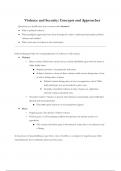College aantekeningen
Lecture notes Violence and Security: Paradigms and Debates (FY)
- Instelling
- Universiteit Van Amsterdam (UvA)
In-depth lecture notes for the course of Violence and security. Includes guiding questions at the beginning of each chapter to aid the learning process. The two guest lectures don't have lecture notes typed but rather short summaries of the content of the accessible papers.
[Meer zien]




